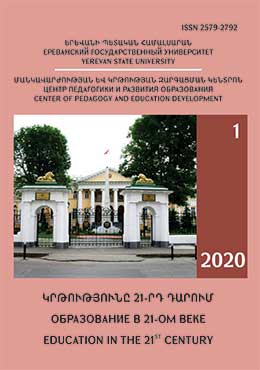PEDAGOGICAL DIAGNOSTICS FUNCTION IN THE LECTURER-STUDENT MENTORSHIP RELATIONS
DOI:
https://doi.org/10.46991/educ-21st-century.v1i3.10846Keywords:
Key words - Mentor, mentee, mentoring relationship, pedagogical diagnostic function, educational environment, educational requirements, mentoring relationship evaluation model, diagnostic model.Abstract
Educational reforms presuppose the provision of quality education, which is possible if the lecturer-student interpersonal relationship is replenished with new quality mentoring relationships. Mentoring involves students' emotional-psychological, professional support, development and development of relevant professional competencies, resulting in the formation of self-awareness and self-realization skills. This relationship implies direct cooperation between the mentor / lecturer / and mentee / student.
During the mentoring relationship, the lecturer mostly uses the social-psychological method of management, mainly manifesting a democratic style of governance, sometimes a liberal style according to the situation. During the cooperation, the mentor uses a pedagogical diagnostic function, which is reversible, as the purpose of the diagnosis and the problems are the chain of further diagnostic actions, which is intertwined with the management functions. And vice versa. The lecturer-student mentor relationship is effective if the lecturer-student communicating couple realizes their social roles, and they can and psychologically are ready for that relationship by performing a pedagogical diagnostic function mutually.
Both the mentoring relationship and the pedagogical diagnosis have developmental stages, which are analyzed with appropriate predictions.
In the introductory / initial / metric phase, a preliminary diagnosis is made, during which the mentor couple mutually exchange some information. During this period, the mentor uses methods from the diagnostic information collection method: observation, survey, interview, survey testing, analysis of current results. The initial diagnosis is followed by the current diagnostic phase, which is comprehensive and multilevel, as the models of mentoring relationships can be changed.
During the current diagnosis, the mentor uses two groups of methods: 1․ Diagnosing information evaluating methods: scaling methods, statistical methods, rating methods, methods for processing the received information and 2․ Applied methods of diagnosed results. The diagnostic methods are modeled on the efficacy model evaluating the mentoring relationship: The Donald Kirpatrick model. At this stage, not only are the achievements and positive behavioral changes analyzed, but also the limitations and omissions in the relationship are identified, new tactical steps are planned, and predictions are made for the further activities planning.
In the final stage, the mentor uses methods to analyze the results. Both the lecturer-student mentoring relationship and the diagnostic function is a developing spiral that must lead to a new quality of development. Since the basis of mentoring relations is the principle of volunteerism, then the mentor-mentee plans their further activities and goals, the expected final results.
References
Игнатьева Е.В., Рябкова Ю.В., Исследование готовности преподавателей универси-тета к осуществлению наставнической деятельности, «Перспективы науки и образования», 2018, № 4, с. 34.
Шилова О.Н., Ермолаева М.Г., Ахтиева Г.Р., Современное состояние и проблемы развития института наставничества молодых учителей, «Человек и образование», 2018, № 4, с. 57.
Ефремов О.Ю., Теория и практика педагогической диагностики в высшей военной школе России, М., 2001.
Воротынцева Т., Неделина Е., Строим систему персонала, СПб., 2008, с. 91.
Бекова М.И., Принципы и этапы реализации педагогической диагностики, «Совре-менные проблемы науки и образования», 2015, № 1, с. 11.
Downloads
Published
How to Cite
Issue
Section
License

This work is licensed under a Creative Commons Attribution-NonCommercial 4.0 International License.

